Food
Notting Hill Carnival is back! Here's everything you need to know
by Nadine Brown
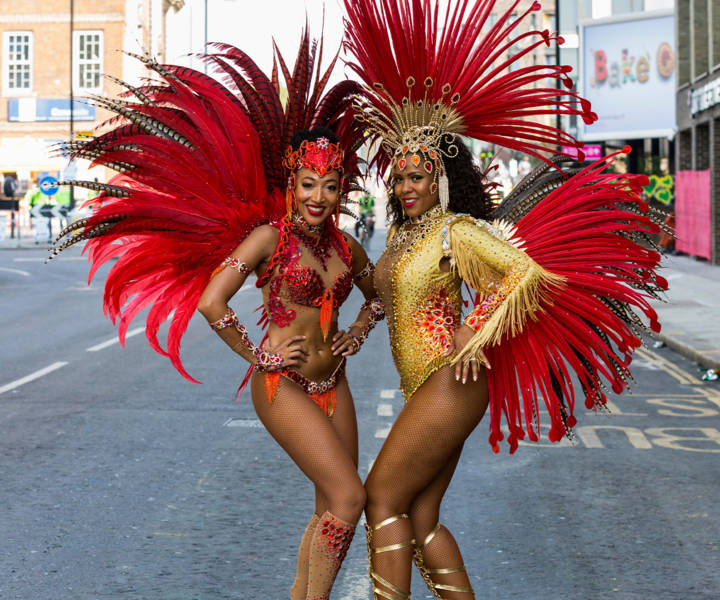
Steeped in Caribbean traditions, Notting Hill Carnival is the street party to beat all street parties, and the celebration that we all need for 2022
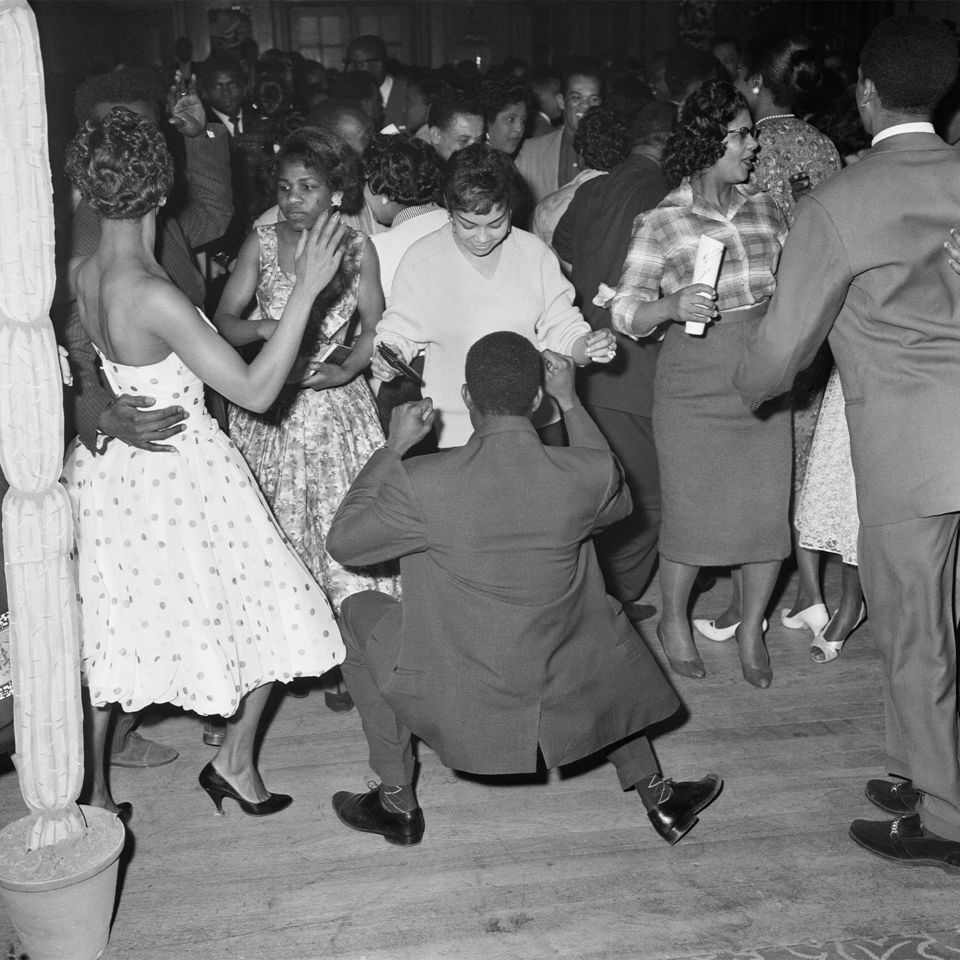
A hot British summertime is never guaranteed, but what you can rely on every August bank holiday, come rain or shine (when there’s not a pandemic), is the institution that is Notting Hill Carnival (NHC).
A stalwart of black British culture since the 60s, it’s 48 hours of bone-rattling sound systems, glorious costumes that dazzle the eyes, floats you follow until your feet cry for mercy and rum you drink to help your brain forget your feet. With a return to the streets of west London after a two-year pandemic-forced hiatus, in the words of soca artist Bunji Garlin: it’s time to get ‘ready for de road’.
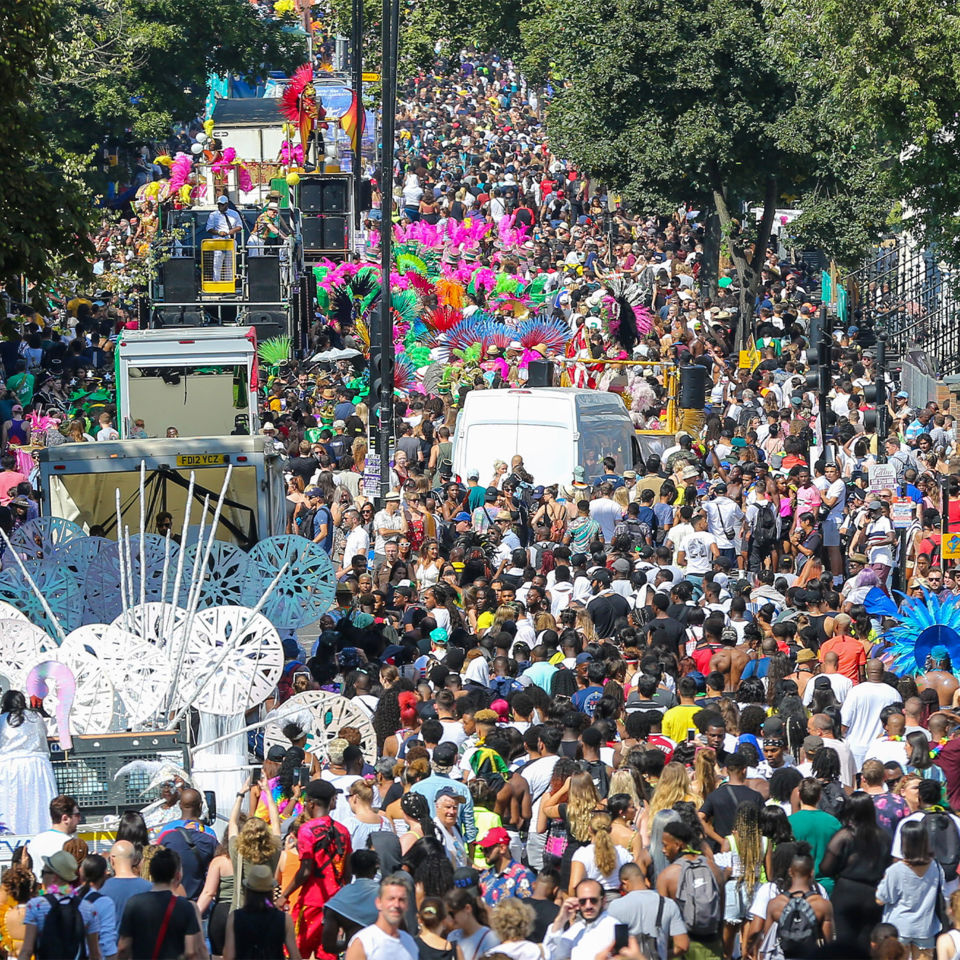
Non-stop party
There’s a misconception about the date that Notting Hill Carnival, the biggest street festival in Europe, starts. To the casual reveller, they’ll be ready to ‘chip’ a little before noon on Sunday morning, horn in hand and a flag to wave. For those taking part in J’ouvert – a tradition with origins in Trinidad that celebrates a freeing from the constraints of the past and a reverence to the ancestors – they’ll have been partying since 6am that same morning, doused in colourful powders and paints.
But for those who live and breathe NHC, who plan its structure, it’s a constant. ‘In terms of our internal team, we work full-time on the event throughout the year. Our planning doesn’t stop,’ Kiana Williams, PA to the chief executive of Notting Hill Carnival Ltd, divulges. ‘Carnival takes place, and then we’re straight into meetings for the next year in the first week of September.’
It’s this rigorous planning (not surprising, with more than 1 million visitors a year) that helps create memories for years and years to come. Natalie D. Marshall, a digital assistant producer at BBC Radio, remembers first visiting carnival with her dad when she was around five years old; she introduced her own daughter at approximately the same age. ‘I recall sitting on my dad’s shoulders in the 80s and always wanting to take part in kiddies’ carnival. Years later, my own daughter got to take part with mas band Funatikals. I loved sharing and passing down carnival culture and celebrating our Caribbean heritage. The vibes, the music – it’s a real community atmosphere.’
Mas bands
Mas bands are one of the ‘five key arts’ of Notting Hill Carnival. Mas is short for masquerade – and participants dress up in the most fantastical costumes, masks and headdresses inspired by the Brazilian Rio Carnival. Everyone can join in to play mas and attendants are encouraged to come in costume too and to start chippin – a specific march, shuffle and dance combo step. Each registered mas band has a new theme every year and takes part in a competition judged across both days with the winners announced on social media.
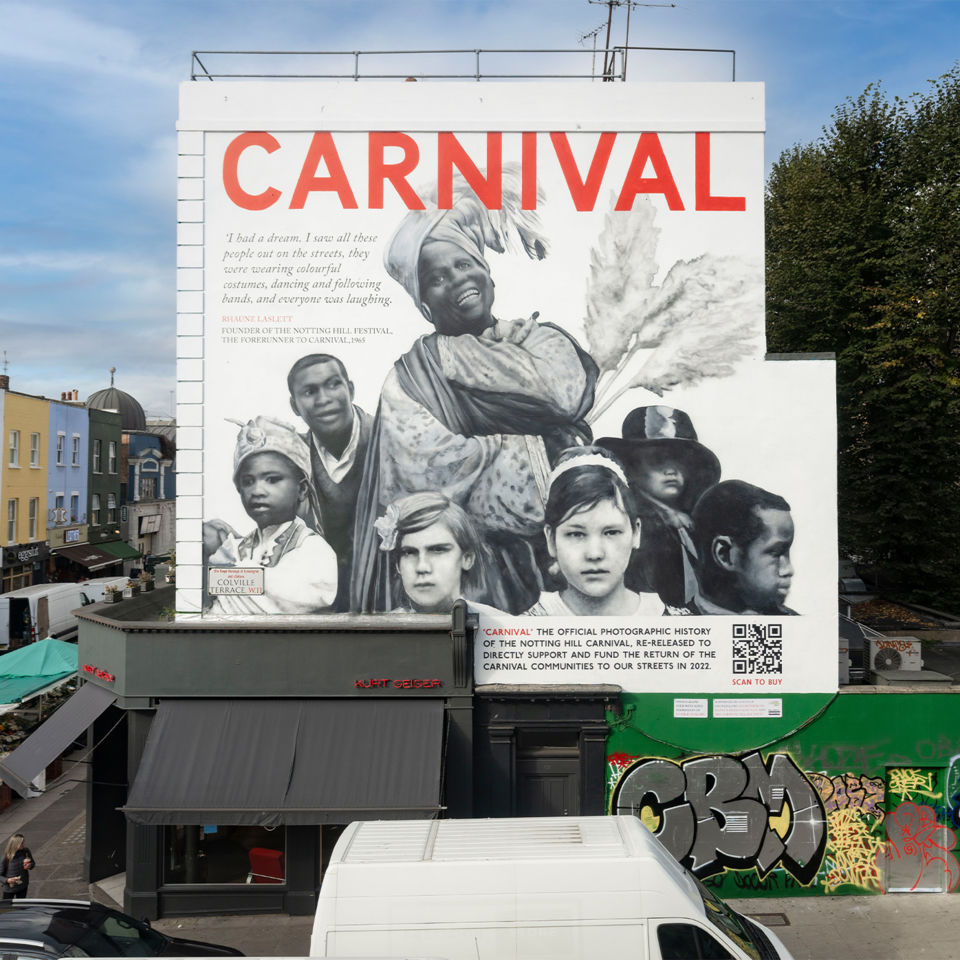
At the heart of it
Essentially, at the heart of Notting Hill Carnival is community. London in the late 50s was a hotbed of racial tension, with an increase of Afro-Caribbean families after the second world war, open hostility encouraged by groups such as Oswald Mosley’s Union Movement, and the Notting Hill Riots – a series of racially motivated attacks during August and September 1958. In response and following visits from concerned members of the black British community, Trinidadian-born Claudia Jones, activist and founder of the West Indian Gazette newspaper, used her connections to organise a carnival in St Pancras Town Hall in January 1959. It’s this event that’s widely considered the initial beginnings of NHC.
Later, in the 1960s, community activists Rhaune Laslett and Andre Shervington continued the work, organising a street festival with an increased focus on local children and music from Trinidadian musician Russell Henderson’s steel band. These elements remain today, with children’s day on the Sunday and the unofficial sound of carnival being the shimmering, melodic tones of a well-beaten steel drum.
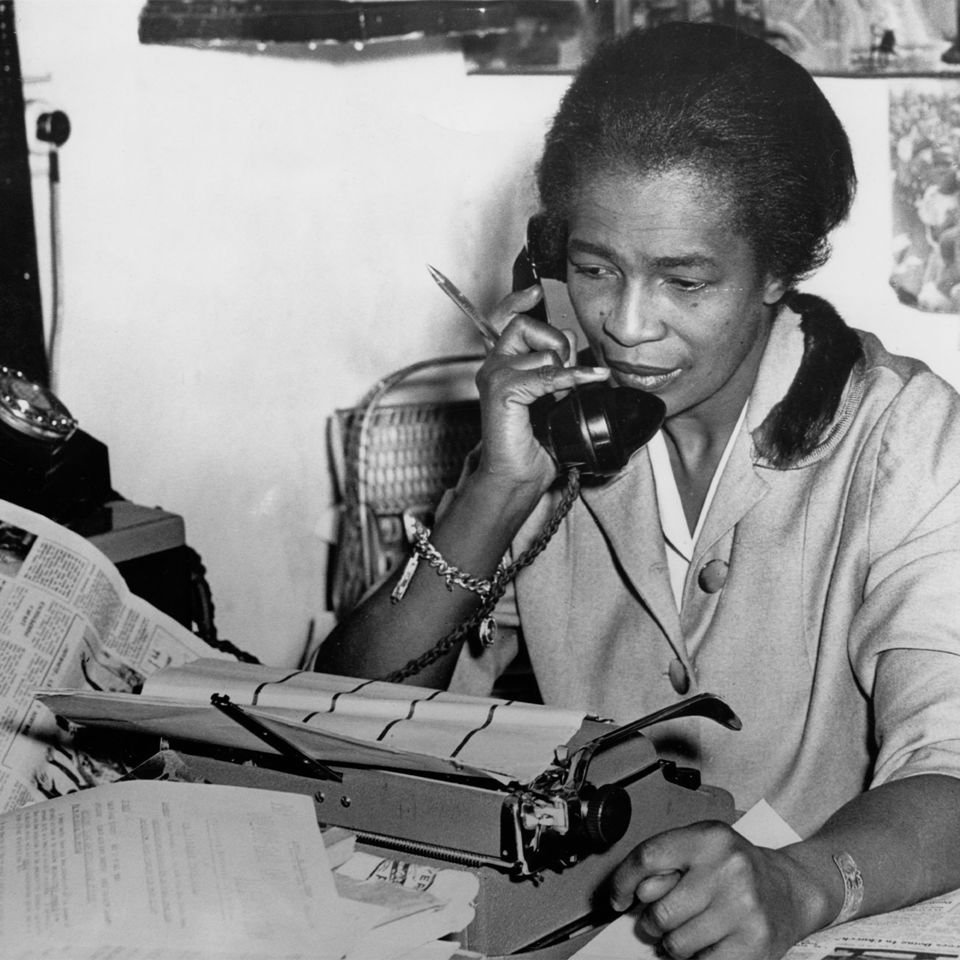
Jammin' and jerk
Of course, you can’t experience all of this without sustenance to see you through, and with more than 300 food stalls selling everything from flaky stuffed patties to aromatic bowls of curry goat hot with Scotch pepper, you’re spoilt for choice. Luke’s Tropical (formerly Banana Skin) is one of those stalls, having traded at NHC for over three decades. Specialising in jerk chicken, its pimento-laced aroma is something you will smell the whole weekend. But in their early days they focused more on sugarcane, fresh young coconut also known as jelly nuts, and sky juice – much like a Slush Puppie but with ice freshly shaved on the spot.
That isn’t the only change to the food scene. Deana Newland, whose dad runs the stall, notes, ‘In the beginning, the other stalls around us were either Caribbean or West African. Of course, as time has gone on and the community has grown,so has the range of food on offer. It’s way more global.’
Other delicious options to look out for are Trinidadian roti– stewed and curried meat and vegin a paratha wrap – and Guyanese pepperpot, a sweet and spicy meat and cassava stew.
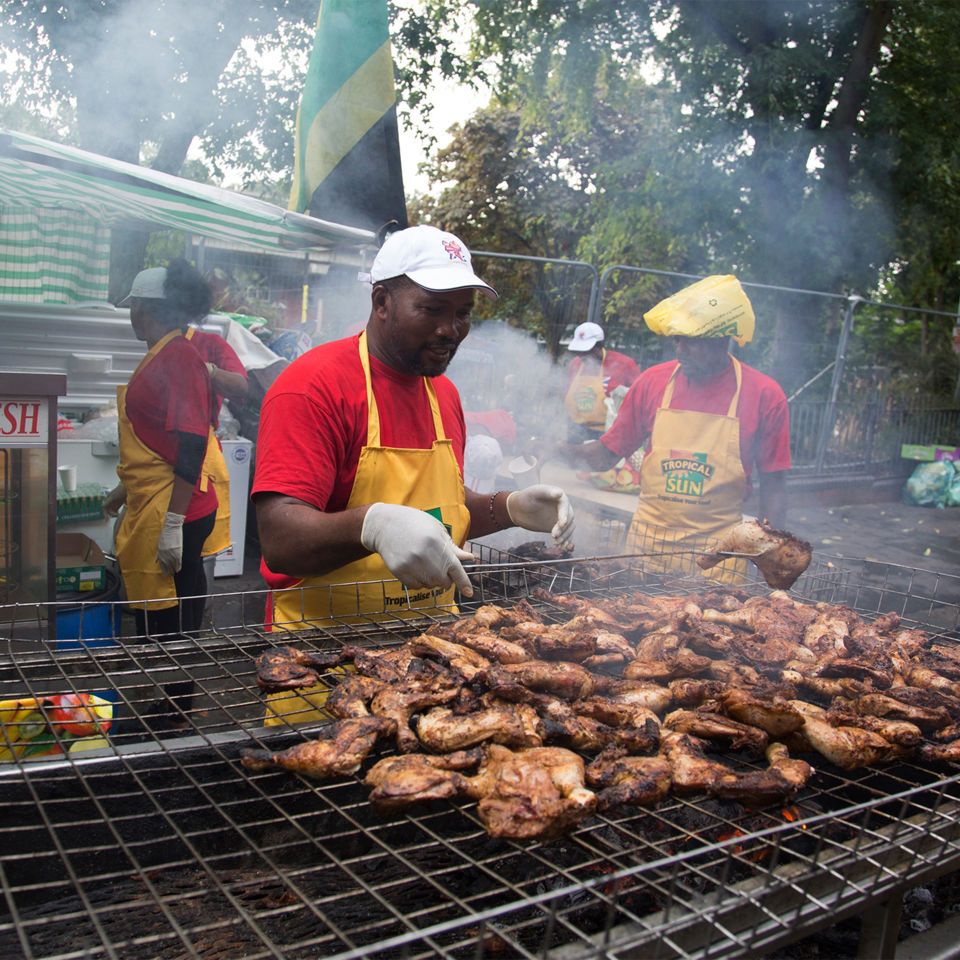
Having more choice is great, but it does make it harder to spot quality dishes – something you’ll be bothered about if you’ve taken it easy on the Red Stripe. Thankfully, Deana has a recommendation: ‘Honestly, it’s hard to go wrong with jerk. It’s marinated for a long time so it’s full of flavour, and the style in which it is cooked means it’s the safest thing to eat on the road. Our jerk is cooked on an open barbecue grill rather than a pan, so it’s moist, not hidden under any char and the flavour is more pronounced. People come back every year for more.’
With its physical absence felt since 2019, Notting Hill Carnival promises to be bigger and better this year. After all, it’s a full-on sensory experience, described perfectly by Kiana. ‘The smell of jerk, the soundchecks, seeing everything come together. It will be comforting to experience that again.’
Comfort is the right word – whether you’re that child sitting on your parent’s shoulders, stationed at your favourite sound system ready to jam, part of a mas band, or tucking into your first curry goat of the day, the comfort of being amongst a community of people just as excited as you are is palpable. Bring on the ‘fete’!
Get the app!
Trying to source where toget a fresh pattie, or where to find your fave DJ? Download the Notting Hill Carnival app (free, iOS and Android) – it will keep you updated on everything going on during the weekend.
Find out more on Instagram @nhcarnivalldn.
5 delicious things to eat at Notting Hill Carnival that aren’t jerk chicken
It’s hard to beat freshly made jerk, but NHC has a lot more to offer. If you’re seeking sustenance after a bout of flag waving/whistle blowing/waist whining, these quick eats will keep you going.
1. Patties
In truth, it doesn’t get much better than a pattie at NHC. Easy to eat on the road, good hot or cold if you’ve forgotten it after hours of dancing, and ridiculously delicious. The only real dilemma is what type you’ll go for… beef and cheese, chicken, vegetable? It won’t be hard to find this classic Jamaican street food, but to ensure you’re eating the best, make sure the pastry is flaky, richly golden and the filling is generous.
2. Bokits
The growth of NHC over the years means a bigger choice of Caribbean islands to choose from when hunting for a snack. Bokits, from Guadeloupe, are the ultimate sandwich of fried dough stuffed with meat, salads and a spicy Creole dressing. They’ve grown in popularity thanks to street food stalls like London's Bokit’la, who will be making an appearance at NHC this year. @bokitla.
3. Seafood
Saltfish fritters, pepper prawns, escovitch fish… the Caribbean and its proximity to the Caribbean Sea means it produces some of the best fish and seafood dishes around. Seek out What’s On The Menu Ish? located on Oxford Gardens for one of their Caribbean seafood fusion dishes – if you’re lucky, they won’t have sold out of their swordfish burgers. @whatsonthemenuish.
4. Buss Up Shut
Roti’s messier cousin is a bit flaky, but in the best ways. A classic roti is ‘beaten’ immediately after being made, giving it its signature torn appearance with layers of buttery pastry exposed. Perfect with curries, grab some of this quintessential Trinidad cuisine on your way to carnival from Roti Joupa Shepherd’s Bush and go on the tastiest walk you’ve ever had. @roti_joupa_shephards_bush.
5. Jelly Nuts/Coconuts
Coconuts are almost as synonymous with carnival as jerk chicken, having been chopped and handed out to revellers as far back as the ‘80s. Sure, rum punch and Red Stripe will get you merry, but hydration is what you need after hours of walking, dancing and (fingers crossed) sunshine, and the fresh, refreshing water inside a vibrant green jelly nut is carnival gold. Look for ones still bright in colour with minimal bruising that lean towards more sweet than sour in taste.












